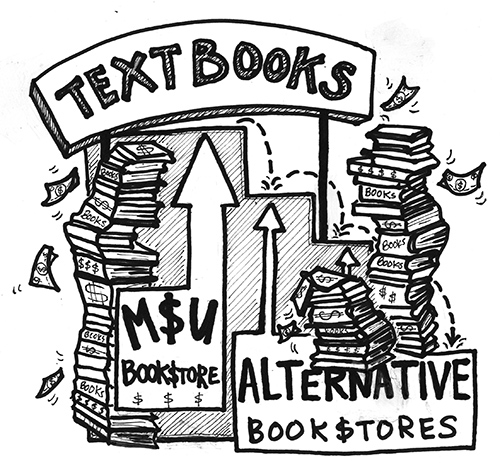The staff editorial is the majority opinion of The Murray State News Editorial Board.

On top of the nightmare that is growing college tuition rates, students have to stress about textbook prices.
According to the American Enterprise Institute, college textbook retail rates grew 812 percent in the past three decades, making them increase faster than healthcare, college tuition rates and the inflation of the economy. This bubble in the education industry means students will spend an average of $655 annually on their books. The University’s former campaign said that buying on-campus means that we are helping bolster the economy of campus. If we eat, shop and live on campus, the idea is that the University will grow.
But does this apply to buying our books at the University Store? One-fifth of this is given to the bookstore to cover operating costs while the rest goes to the publishers.
While we grimace at our textbook receipts we should consider the sources of our frustration.
The Internet is the main culprit when it comes to rising textbook prices. Students who try to dodge retail prices will look to places like Chegg and Amazon to cut costs. Chegg allows students to rent discounted textbooks, and Amazon sells used and older editions of books for a fraction of bookstore prices.
This leaves publishers with limited options to make a profit. In turn, they overprice their material and make new editions as often as yearly to make their product relevant. These ballooning prices are then handed down to the University, which has no choice but to sell at retail.
The rise in textbook prices is leading to an overall lack of commitment from students, who will rent or buy older editions before they decide to pay full price on new books.
Sometimes, we choose to not buy textbooks at all. We’re afraid to buy new because we know we will get less than half of its worth when we go to sell back.
Long lines at the bookstore, long receipts and Chegg shipping boxes are indicators that we have accepted our fate. We make big purchases assuming that textbooks are a fact of college life and we should just put them on our student accounts and move on, but we could try more innovative options.
For professors, getting students to read chapters before class can be nearly impossible. as much as we pay for the books, they don’t see much action.
Other universities have experimented with innovative curriculum that eliminate textbooks altogether. The University of Kentucky offers iPads at discounted prices so students can access information online instead of using books. Professors will encourage students to bring their tablets and laptops to class before they tell them to bring the book. They can access PDFs online, download educational programs and expand beyond the one dimension of textbooks.
Some courses are also learned completely on CDs or applications because they engage students with practical exercises. If the University partnered with developers of educational softwares, they could avoid the prices of publishers while still making a profit that won’t leave students in more debt.
There will be opponents of going digital in education, but this change can teach students how to think critically, use more than one source of information and draw their own conclusions about how they best learn material. Sometimes, the old way is the best way. But because we can barely afford to keep up with our old ways, we should consider embracing change.